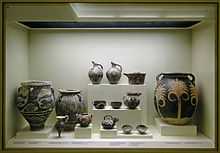Kamares ware

Kamares wares are a distinctive type of ceramic produced in Crete during the Minoan period, dating to MM IA (ca. 2100 BCE). By the LM IA period (ca. 1450), or the end of the First Palace Period, these wares decline in distribution and "vitality".[1] They have traditionally been interpreted as a prestige artifact, possibly used as an elite table-ware.
The designs of kamares ware are typically executed in white, red and blue on a black field. Typical designs include abstract floral motifs.
Surviving examples include ridged cups, small, round spouted jars, and large storage jars (pithoi), on which combinations of abstract curvilinear designs and stylized plant and marine motifs are painted in white and tones of red, orange, and yellow on black grounds. At this time, this characteristic type of pottery was produced, with red, orange and white painted decoration on a dark background. The Kamares style was often elaborate, with complex patterns on pottery of eggshell thinness. This small drinking cup shows a simple version. Sets of cups and jugs have been found, and it has been suggested that these may have been used in ritual, though Kamares pottery presumably also graced the dining tables of the First Palaces.
Surprisingly, the first Kamares pottery found in excavation came from Lahun in Egypt, and was discovered by Flinders Petrie. It is now in The British Museum.
Today I will introduce the Kamares ware at Hazor, there are two sherds at Hazor. One was Trude Dothan and the other was Sharo Zuckerman. These two sherds whose grey-black and decoration. Kamares ware were found during the second season of excavations at Tel Hazor, in Area C in the lower city; Some of Kamares Ware were published in Hazor II but some of Ware have been considered lost. There was one discovery of the sherds in 1956. “It is hoped that this publication will enable a fresh consideration of the material, given all the knowledge gained since the discovery of the sherds in 1956, especially on the subject of early second-millennium connections between Crete and the Eastern Mediterranean sphere. There was spiral decorated Kamares sherd from Hazor. There was consists of two joined fragments that were found in L.6206. About the Spiral decorated Kamares sherd’s interior and exterior were same to each other. The decorative pattern of interior and exterior were same, but their shapes were difference.
About the aforementioned of Spiral decorated Kamares sherd consists of two adjoining fragments. It was relatively thick about 8mm, and is made of pink (5Y/R7?4, according to the Munsell colour charts) well-levigated clay, well fired without a core. The Fig 1 is under on there and to mean about fragments of Spiral decorated Kamares sherd. A modeled rim about this Spiral decorated Kamares sherd had a modelled rim was found in L. 6212, an alley south of Building 6205. There is one image to explain the Modelled rim from Hazor.
Spiral decorated Kamares sherd forms a rim with two protuberances, this was part of an entire row. The clay is grey (2.5Y 5/) with small white grites. The sherd is covered with dark grey to dark brown (10 YR 4/1-10 YR 4/3) self-slip and is burnished.
About petrographic analysis, there attempt to clarify Spiral decorated Kamares sherd's provenance. The method about Spiral decorated Kamares sherd provenance was chosen due to several analytical problems. There occurred during over three decades of scientific work carried out on Cretan ceramic.
There was a distinction that is very relevant for Spiral decorated Kamares sherd's provenance. And chemical analysis faced difficulties in distinguishing between pottery from sites within the Mesara Plain and north-central Crete. About the petrographic, Day23 is one kind of method procedure used for the Hazor sherds.[2]
References
- ↑ Dickinson, Oliver. 1994. The Aegean Bronze Age. Cambridge University Press.
- ↑ http://www.jstor.org.proxy2.cl.msu.edu/stable/27926913?seq=5 Trude Dothan, Sharon Zuckerman and Yuval GorenIsrael “Israel Exploration Journal” Page 1-15
External links
| Wikimedia Commons has media related to Kamares style. |